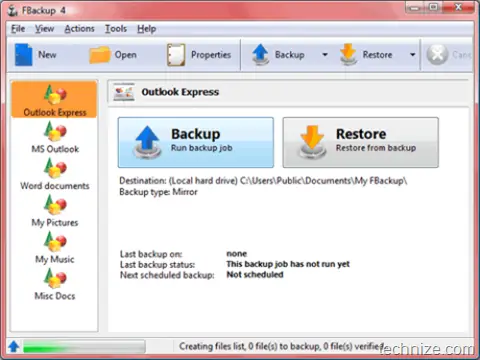If you have a Windows server and you're not backing it up, you are tempting fate. It's only a matter of time before something tragic will happen: a hardware failure, a hacker, or a corrupted Windows update. Something will bring that server down and do everything it can to take your data with it.
Luckily, several reliable backup solutions are available for the Windows Server environment. They aren't perfect. But the five solutions discussed here have their strengths and can be depended upon to keep your data safe. Now, before I reveal the big five, I want to make sure you understand how critical it is to be backing up that data to an external drive and to rotate that drive offsite. If you're backing up drives and leaving everything onsite, should a fire (or some other catastrophe) occur, that data will be lost.
Windows Free backup software is exactly what you think it is: completely free software that can be used to manually or automatically back up the important data on your computer hard drive to somewhere safe like a disc, flash drive, network drive, etc. BackupAssist produces windows server backup software build for SMB'sand SME's. Our backup software offers incremental backup, onsite backup, offsite backup, and rapid recovories for disaster recovery and business continuity. A couple of other software applications you can consider are for cloud backup software. Although you install the application on your PC or other device, your files are backed up in the cloud.
Note: This list is also available as a photo gallery.
1: Acronis Backup and Restore (with Universal Restore)
Windows Server Backup Software
Acronis Backup and Restore (Figure A) is the backup tool I use the most. It's costly but well worth it. The newer version of Acronis does a great job of ensuring that there is room on your external drive for your latest backup. You can overwrite the old backup or go by the traditional cleanup rules established in Acronis Echo. But if you go the Acronis route, you should also purchase the Universal Restore feature. With this tool, you can take a full image of a backup and restore it to any hardware — so long as it meets the requirements of your platform. That way, you don't need an exact duplicate of your server hardware sitting around waiting to have an image restored onto it. Acronis also has add-ons for Exchange and SQL Servers.Figure A
Acronis Backup and Restore
2: Symantec Backup Exec
 Symantec Backup Exec (Figure B) is a powerful backup solution that does a great job of 'just working.' And with its at-a-glance calendar, it's easy to know when your backup has succeeded and when it has worked. If you're using Symantec Backup Exec across a network (to back up clients/hosts), you can feel safe because it uses SSL for all network backup connections. Like Acronis, Symantec offers solutions for Exchange and SQL. Also, the ability to manage Vaults (backup destinations) is superb with Symantec. Just make sure that if a Vault is physically (and permanently) removed, you remove it from within the backup software. Otherwise, it will cause problems.
Symantec Backup Exec (Figure B) is a powerful backup solution that does a great job of 'just working.' And with its at-a-glance calendar, it's easy to know when your backup has succeeded and when it has worked. If you're using Symantec Backup Exec across a network (to back up clients/hosts), you can feel safe because it uses SSL for all network backup connections. Like Acronis, Symantec offers solutions for Exchange and SQL. Also, the ability to manage Vaults (backup destinations) is superb with Symantec. Just make sure that if a Vault is physically (and permanently) removed, you remove it from within the backup software. Otherwise, it will cause problems.Figure B
Symantec Backup Exec
3: Carbonite
Carbonite (Figure C ) is primarily an online backup (although the Business and BusinessPremier plans allow you to back up to an external drive). It's meant to back up data only. Carbonite is probably one of the most reliable online backup tools and can back up email, documents, POS files, financial data, pictures and other multimedia, and more. But to use Carbonite for Windows Server, you must use the BusinessPremier Plan ($229.00 per year), which will allow you to include as many servers running Window Server 2003/2008/2011 as you like. Unlike Acronis, you won't be backing up an image of your server with Carbonite — it's at offer many of the bells and whistles of the other tools, it is one of the only truly reliable backup solutions that will clear the Exchange logs for you. I always set up an NT Backup to run once a week (or month, depending upon the needs), just to have it clear the Exchange logs. Otherwise, you'll be including a lot of unnecessary data in your backups, causing their size to get out of hand.
) is primarily an online backup (although the Business and BusinessPremier plans allow you to back up to an external drive). It's meant to back up data only. Carbonite is probably one of the most reliable online backup tools and can back up email, documents, POS files, financial data, pictures and other multimedia, and more. But to use Carbonite for Windows Server, you must use the BusinessPremier Plan ($229.00 per year), which will allow you to include as many servers running Window Server 2003/2008/2011 as you like. Unlike Acronis, you won't be backing up an image of your server with Carbonite — it's at offer many of the bells and whistles of the other tools, it is one of the only truly reliable backup solutions that will clear the Exchange logs for you. I always set up an NT Backup to run once a week (or month, depending upon the needs), just to have it clear the Exchange logs. Otherwise, you'll be including a lot of unnecessary data in your backups, causing their size to get out of hand.Figure D
Windows NT Backup
Windows Server Backup Software Free
5: ShadowProtect 4 (Server)
ShadowProtect 4 ( Figure E) is probably the least-known product in this list. But it falls into place next to Acronis as a feature-rich tool that can do everything — including recover to dissimilar hardware. ShadowProtect 4 also includes an easy-to-use tool that allows you to consolidate backup image files and convert the backups to either .VHD or .VMDK virtual machines. Another outstanding feature is its granular recovery, which allows for the quick recovery of individual files from within a backup. Unique to ShadowProtect is the Virtual Boot technology, which provides for automatic failover to a virtual server.
Figure E) is probably the least-known product in this list. But it falls into place next to Acronis as a feature-rich tool that can do everything — including recover to dissimilar hardware. ShadowProtect 4 also includes an easy-to-use tool that allows you to consolidate backup image files and convert the backups to either .VHD or .VMDK virtual machines. Another outstanding feature is its granular recovery, which allows for the quick recovery of individual files from within a backup. Unique to ShadowProtect is the Virtual Boot technology, which provides for automatic failover to a virtual server.Figure E
ShadowProtect 4
Which backup?
Every company needs a backup plan. How far you go with your backup depends upon the size of the company, your needs, and your budget. But any of the above solutions will serve as a great place to start — or stop — for your Windows Server backup needs. Do you have a different backup solution to add to the list? Share your recommendations with fellow TechRepublic members.